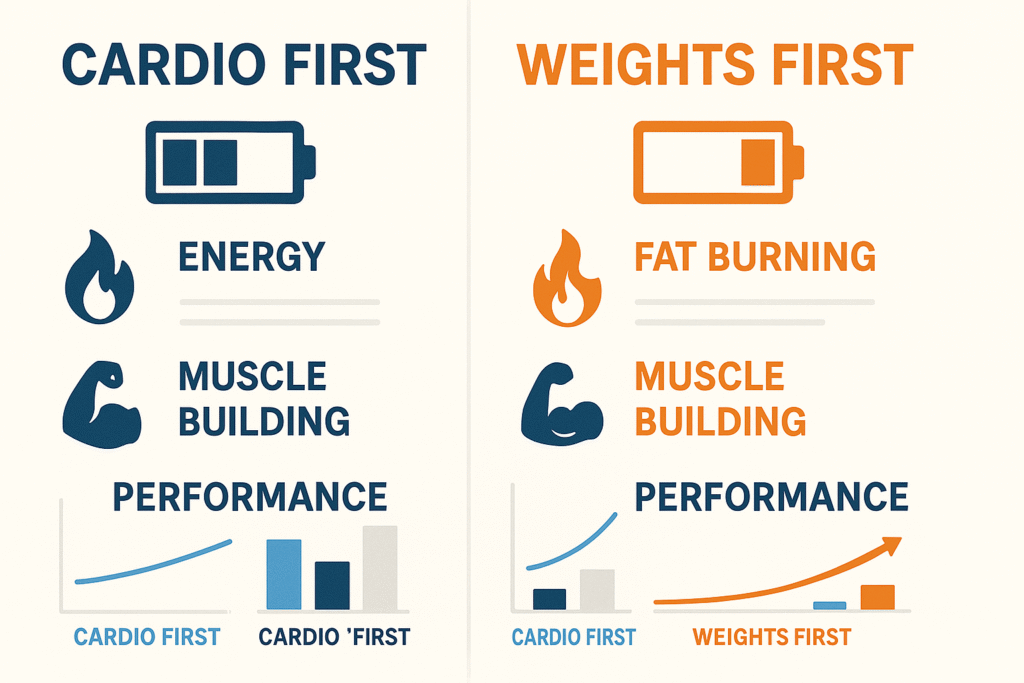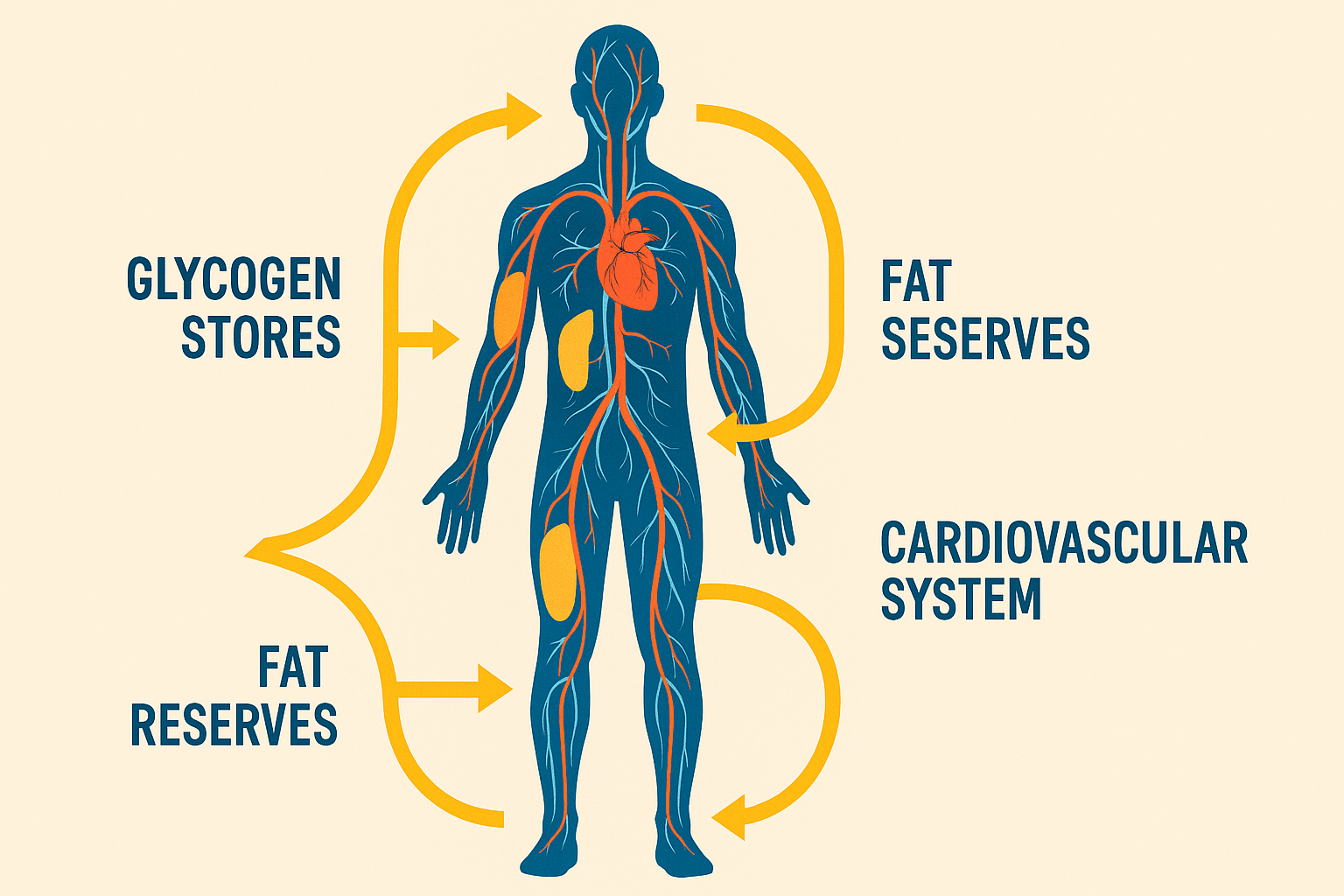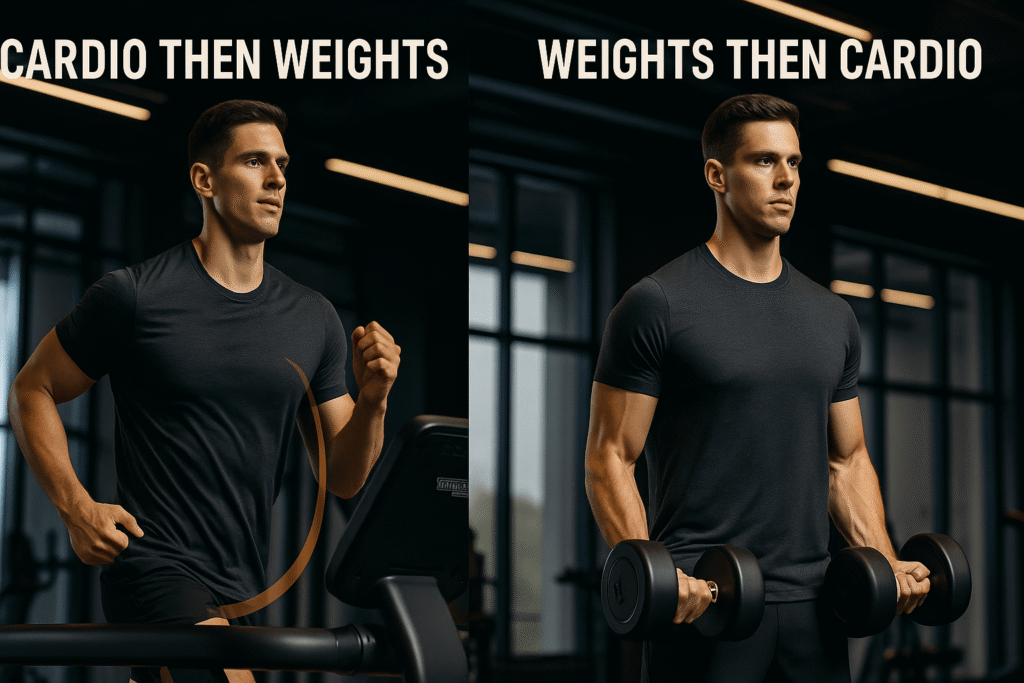Walking into the gym with a plan is half the battle won, but one question continues to perplex fitness enthusiasts at every level: should you hit the treadmill first or grab those dumbbells? The cardio before weights debate has raged in fitness circles for decades, and while the answer isn’t always black and white, recent research provides compelling evidence to guide your workout sequence.
The truth is, exercise order significantly impacts your results, safety, and overall workout effectiveness. Whether you’re aiming for fat loss, muscle building, or improved cardiovascular health, understanding the science behind workout sequencing can transform your fitness journey.
The Science Behind Exercise Order
Your body operates like a sophisticated energy management system, prioritizing fuel sources based on exercise intensity and duration. When you begin any workout, your muscles primarily rely on stored glycogen (carbohydrates) for immediate energy. This metabolic reality forms the foundation of why exercise sequence matters.
During strength training, your muscles demand quick, powerful bursts of energy, drawing heavily from glycogen stores. Cardiovascular exercise, particularly at moderate intensities, can utilize both glycogen and fat for fuel, though the ratio depends on various factors including fitness level, exercise intensity, and duration.
Recent research involving 45 obese young men over 12 weeks revealed fascinating insights into how exercise order affects body composition. Participants who performed weight training before cardio experienced significantly greater fat loss and visceral fat reduction compared to those who did cardio first. The weights-first group also increased their daily activity levels by an impressive 3,500 additional steps compared to just 1,600 in the cardio-first group.
When to Do Strength Training First

For Maximum Fat Loss Results
If fat loss tops your fitness priorities, the evidence strongly supports doing strength training before cardio. Here’s why this sequence creates a metabolic advantage:
- Glycogen depletion strategy: Weight training depletes your muscle glycogen stores, forcing your body to tap into fat reserves during subsequent cardio
- Enhanced fat oxidation: With reduced glycogen availability, your body becomes more efficient at burning fat for fuel during aerobic exercise
- Increased daily activity: Research shows the weights-first approach naturally increases spontaneous physical activity throughout the day
For Building Muscle and Strength
Strength training demands precise form, maximum effort, and full muscle activation. Performing cardio first can compromise these critical elements:
- Reduced lifting performance: Pre-fatigued muscles from cardio cannot generate the same power output needed for effective strength training
- Decreased training volume: Fatigue from cardio limits the number of sets and reps you can complete with proper form
- Higher injury risk: Tired muscles are more prone to form breakdown and potential injury during heavy lifting
For Athletic Performance
Athletes and serious lifters should prioritize strength training when both modalities are included in the same session. The neuromuscular demands of lifting require fresh muscles and optimal coordination, which cardio can significantly impair.
When Cardio Before Weights Makes Sense

Endurance Sport Preparation
If you’re training for a marathon, triathlon, or other endurance events, prioritizing cardio aligns with your primary performance goals:
- Sport-specific adaptation: Your body adapts to the demands you place on it first and most intensely
- Energy system development: Endurance athletes need to maximize their aerobic capacity and efficiency
- Training periodization: During peak endurance phases, cardio takes precedence over strength work
Cardiovascular Health Focus
For individuals primarily concerned with heart health and cardiovascular fitness, starting with cardio ensures you can complete your aerobic exercise at the desired intensity:
- Consistent cardio quality: Fresh muscles allow you to maintain target heart rate zones throughout your cardio session
- Improved adherence: If cardio is your main goal, doing it first when motivation is highest increases consistency
Active Recovery Days
Light cardio before strength training can serve as an effective warm-up strategy:
- Increased blood flow: Gentle cardio elevates heart rate and increases circulation to working muscles
- Enhanced mobility: Light movement can improve joint range of motion before lifting
- Mental preparation: Easy cardio can help transition from daily stress to focused training
The Role of High-Intensity Interval Training (HIIT)
HIIT represents a unique middle ground in the cardio versus weights debate, combining cardiovascular and strength benefits in time-efficient workouts. However, this intensity comes with important considerations:
Benefits of HIIT Training
- Time efficiency: Combines cardio and strength elements in shorter sessions
- Metabolic boost: Creates significant post-exercise oxygen consumption (EPOC)
- Versatility: Can be adapted for various fitness levels and equipment availability
HIIT Limitations and Precautions
- Recovery demands: High-intensity work requires adequate rest between sessions
- Frequency restrictions: Limit HIIT to 2-3 sessions per week maximum to prevent overtraining
- Skill requirements: Proper form becomes crucial when fatigue sets in during high-intensity intervals
Optimizing Your Workout Structure

The Ideal Weekly Framework
For most fitness enthusiasts, a balanced approach includes:
- Cardiovascular exercise: 150 minutes of moderate-intensity or 75 minutes of vigorous-intensity aerobic activity per week
- Strength training: At least two full-body resistance training sessions per week
- Flexibility and mobility: Regular stretching and mobility work to support both cardio and strength training
Practical Programming Strategies
Option 1: Separate Days
- Dedicate specific days to cardio and strength training
- Allows maximum effort and recovery for each modality
- Ideal for serious athletes or those with ample training time
Option 2: Weights First, Then Cardio
- Complete strength training when energy levels are highest
- Follow with 15-30 minutes of moderate-intensity cardio
- Best for fat loss and general fitness goals
Option 3: Cardio First for Specific Goals
- Reserve for endurance training phases or cardiovascular health focus
- Keep cardio intensity moderate to preserve strength training quality
- Monitor strength performance and adjust as needed
Special Considerations for Different Populations

Women and Hormonal Factors
Female athletes and fitness enthusiasts may experience different responses to exercise sequencing based on hormonal fluctuations throughout their menstrual cycle. During certain phases, strength training capacity may be enhanced, while other times favor endurance activities.
Older Adults and Recovery
As we age, recovery between exercises becomes increasingly important. Older adults may benefit from longer rest periods between cardio and strength training, or separating these modalities entirely to optimize adaptation and minimize injury risk.
Beginner Considerations
New exercisers should prioritize proper form and gradual progression over complex sequencing strategies. Starting with shorter, less intense sessions allows the body to adapt while building sustainable exercise habits.
Nutrition Timing and Workout Sequence
The relationship between nutrition timing and exercise order adds another layer of complexity to workout programming:
Pre-Workout Nutrition
- Carbohydrate timing: Consuming carbs 1-2 hours before training can support both cardio and strength performance
- Protein considerations: Including protein in pre-workout meals supports muscle protein synthesis
- Individual tolerance: Some people perform better fasted, while others need fuel
Post-Workout Recovery
- Glycogen replenishment: Important regardless of exercise order, but timing may vary
- Protein synthesis: Strength training creates a longer window for muscle protein synthesis
- Hydration: Critical for both cardiovascular and strength training recovery

Common Mistakes to Avoid
Overcomplicating the Process
Many fitness enthusiasts get paralyzed by analysis, spending more time planning than actually exercising. Remember that consistency trumps perfect programming every time.
Ignoring Individual Response
While research provides general guidelines, individual responses to exercise sequencing can vary significantly. Pay attention to your body’s signals and adjust accordingly.
Neglecting Recovery
Regardless of exercise order, adequate recovery between sessions remains crucial for adaptation and injury prevention.
Making the Right Choice for Your Goals
The cardio before weights question ultimately depends on your primary fitness objectives:
Choose weights first if you want to:
- Maximize fat loss and body composition changes
- Build muscle mass and strength
- Improve athletic performance
- Reduce injury risk during lifting
Choose cardio first if you want to:
- Prepare for endurance events
- Prioritize cardiovascular health
- Use light cardio as an extended warm-up
- Focus primarily on aerobic fitness
Frequently Asked Questions
Q: How long should I wait between cardio and strength training in the same session?
A: Allow 5-10 minutes of active recovery between modalities. This brief rest period helps your heart rate normalize and allows you to mentally prepare for the next phase of your workout.
Q: Can I do cardio and weights on the same day if I’m trying to build muscle?
A: Yes, but prioritize strength training first and keep cardio sessions moderate in intensity and duration. Excessive cardio can interfere with muscle building, but moderate amounts can actually support recovery and overall health.
Q: Is it better to do full-body strength training or split routines when combining with cardio?
A: For most people combining cardio and weights, full-body strength sessions 2-3 times per week work well. This approach allows for adequate recovery while maintaining training frequency for both modalities.
Q: How does exercise order affect weight loss specifically?
A: Research suggests that doing weights before cardio may enhance fat loss through improved fat oxidation during the cardio portion. However, the most important factor for weight loss remains creating a consistent caloric deficit through diet and exercise.
Q: Should beginners worry about exercise order?
A: Beginners should focus on consistency and proper form before worrying about optimal sequencing. As fitness improves and goals become more specific, exercise order becomes more relevant.
The Bottom Line: Your Workout, Your Rules
While science provides valuable insights into exercise sequencing, the best workout order is ultimately the one you can stick with consistently. The research clearly shows that doing strength training before cardio offers advantages for fat loss and muscle building, but these benefits mean nothing if the approach doesn’t fit your lifestyle, preferences, or goals.
Start with the evidence-based recommendations, but don’t be afraid to experiment and adjust based on your individual response. Track your progress, listen to your body, and remember that showing up consistently matters more than perfect programming.
Whether you choose to sweat it out on the treadmill first or pump iron before hitting the cardio machines, the most important step is taking action. Your fitness journey is unique, and the best exercise sequence is the one that keeps you moving toward your goals, day after day.
Ready to put this knowledge into practice? Choose your approach based on your primary goals, give it at least 4-6 weeks to assess results, and adjust as needed. Your body will thank you for the thoughtful approach to your training, and your results will reflect the science-backed strategy you’ve implemented.




Pingback: How SMART Fitness Goals Can Transform Your Health Journey: A Complete Guide to Sustainable Success - wholesomefed